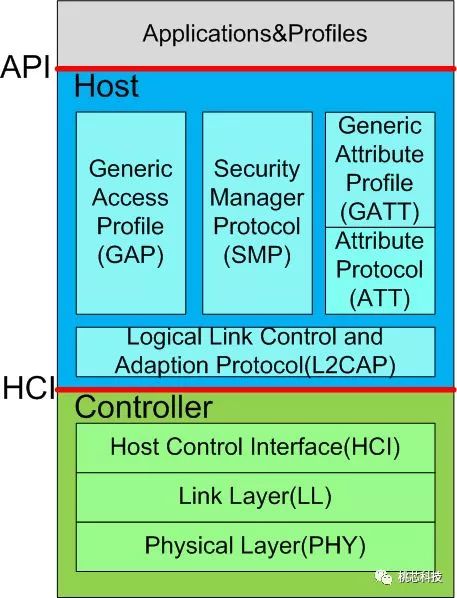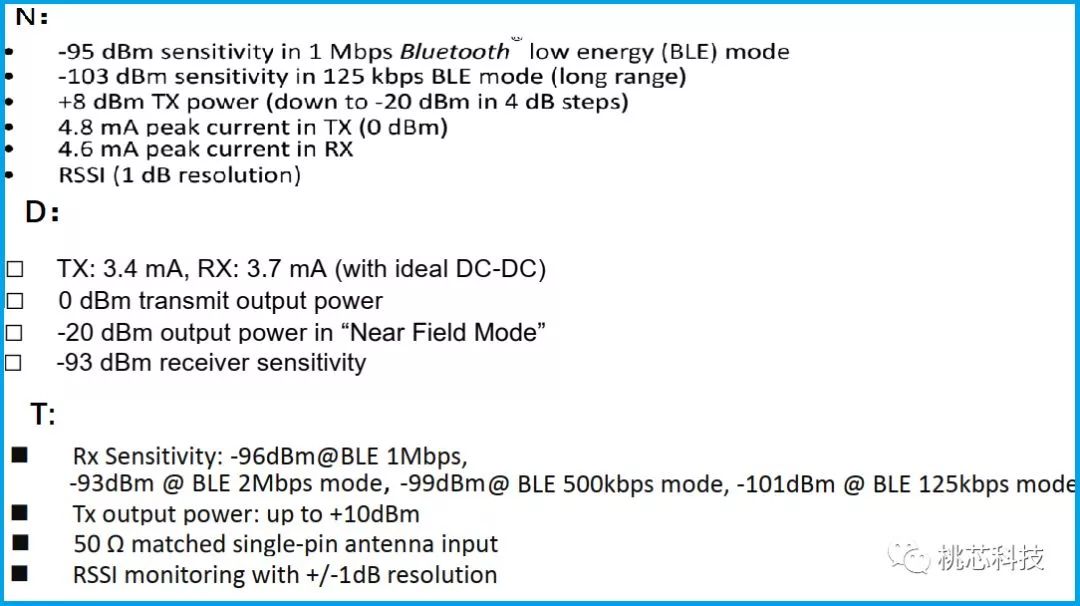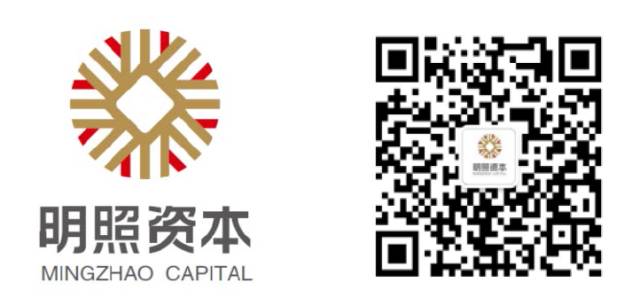In this article, we selected several chips from high, medium, and low-end categories, focusing on BLE, including N, D, T, and other currently representative chips, to discuss.
First, let’s understand what the Bluetooth protocol is. Typically, in a wireless communication protocol, data needs to be packaged from the application layer to the air interface. Ignoring the internet layer, the processing steps (on the sending side) are as follows: encryption at the application layer, encoding at the application layer, high-level protocol encapsulation, low-level protocol encapsulation, low-level encryption, physical channel encoding, modulation, and radio frequency front-end. The receiving side is the opposite. Regarding the Bluetooth protocol, it can be simplified and represented as shown in the figure below.

Next, we selected five key features for comparison to explore the differences among these Bluetooth chips.

D’s processor is just M0, with a frequency of only 16MHz. This indicates that even with built-in Flash, D does not need a cache. At the same time, we can predict that this chip can only run the Bluetooth protocol stack, which is the software for the Host+Link part shown in the above figure, and the upper application part will be quite laborious, or rather unlikely. Slightly complex applications must be solved with an additional CPU chip. Returning to memory, we see it is configured with 2MB Flash, so the possibility of built-in Flash can be excluded, as current technology does not support such a large built-in Flash. It should be a SIP Flash. Additionally, we can see that it has 64K OTP and 128KB ROM, indicating that it has solidified the protocol stack of the LINK part (possibly also adding some HOST) in the above figure; otherwise, there would be no need to use such a large OTP and ROM. The purpose of the 96K SRAM is to support more connections.
T’s processor is approximately equivalent to M0, so its capability is relatively weaker, but the frequency can reach 48M, which should be able to handle most applications. However, since it is not an M series, software developers may hesitate when choosing. Looking at the data supporting cache and 512KB Flash, it should theoretically be embedded Flash. The only question is to see who fabricates the chip; T’s should be fine, but S’s 512KB Flash raises a big question mark. We won’t speculate on the specifics; interested friends need to understand carefully.
One point to mention is that when studying chip performance, we should not only look at the size of the memory but also understand the implications behind the memory and its impact on applications. Simply looking at memory numbers is not very meaningful.
N’s high-end model supports all Bluetooth 5 features, including 2Mbps, Long Range, and Advertising Extension. However, other models do not support Long Range. D’s specification only mentions that it supports all new Bluetooth 5 features but does not specify, so we can only know for sure after using it.T’s specification mentions support for 2Mbps and Long Range but does not support Advertising Extension.
From the above, it can be seen that very few chips on the market truly support all specifications of Bluetooth 5. N has a chip that fully supports Bluetooth 5, but in terms of pricing, the one supporting Long Range is also very high-end. However, only N clearly states the features it supports, while others are yet to be evaluated.
Based on the discussion of RF characteristics, let’s first look at the table below.

For a clearer comparison, we extracted some important indicators, as shown in the table below:

It is particularly noted that for 125Kbps Long Range, D has not provided specific figures for Long Range. Referring to the previous Feature List, D has not separately mentioned various Bluetooth 5 features, so there are certain doubts about D. The maximum transmission frequency is related to RF design definitions; the greater the transmission power, the larger the area and power consumption, and we also see some chips describing figures with external amplification circuits. In terms of power consumption performance, since TX is related to transmission power, it is not explicitly stated, so we mainly look at RX here. The RX corresponding figures are 4.6mA/3.7mA/xx. Here, it refers to the power consumption of the RF front end; N directly states it is peak power consumption, although D does not specify, but it is usually the case. T has not mentioned its specific performance.
For different chips, we also need to look at the specific basic power consumption, including power consumption when idle, power consumption in power-saving mode, and RF restart time, etc. This is related to the SoC power-saving strategy and has a considerable impact on battery life. In addition, RF indicators are relatively troublesome to test, and it is easy to write some special figures, so users need to see whether these affect applications and whether they need to be rigorously tested.
Regarding low power, we hope to see the SoC’s power consumption in different states. We see N’s:
-
0.3 μA at 3 V in System OFF mode
-
1.9 μA at 3 V in System ON mode, no RAM retention, wake on RTC
0.3uA represents the leakage current of the chip when powered off; 1.9uA represents the power consumption of the chip when only the RTC counter is active. Both points are valuable information. However, besides this, we also hope to see other working circuit indicators. Although different manufacturers have their own statements and focuses regarding other circuit indicators, we need to define what these indicators specifically include, such as broadcast state, 125ms sleep, and average power consumption of the chip; in most application scenarios, we may only care about these three basic power consumptions, which represent the battery life of the chip in powered-off state, RTC state, and working state under the same power.
When writing this article, we were unable to obtain data from D regarding low power. Therefore, let’s directly look at T’s relevant description:
-
whole chip rx mode:5.3mA
-
whole chip tx mode:4.8mA@0dBm
It should be noted that the above two descriptions are very vague; these figures are clearly not peak currents because, at the current industry level, just the RF peak power consumption can reach this figure, and adding the CPU and peripherals, the overall peak current will definitely exceed this. If T’s provided data refers to average current, it should clearly describe what state this figure is under. Just a simple summary like the above is meaningless to users.
In summary, finding the key data that affects battery life is our main concern, and the focus on other data can be adjusted based on individual needs.
Although low-power Bluetooth is not just a communication chip, it also includes many applications defined by SIG. Even though many chips’ CPU capabilities can already handle these applications, for peripherals, unless targeting specific scenarios, the peripheral interfaces of general-purpose chips are still ordinary I2C, UART, SPI, PWM, etc.
Other aspects that affect chip applications include the BOM list; users need to look at the overall solution’s price, not just the chip itself. If using a chip results in a high BOM list, then the chip’s low price becomes meaningless. Additionally, other indicators, including the friendliness and simplicity of the SDK, are also factors that developers need to consider.
The chip market, although not as diverse as other consumer goods markets, is only a few manufacturers. If not carefully understood, chips may seem similar. However, the user experience will certainly differ significantly. The above discussion on various indicators and parameters of Bluetooth chips is hoped to serve as a catalyst to help developers choose the chip that is more suitable for them.
Peach Chip Technology was established in September 2017, dedicated to achieving domestically owned Bluetooth 5.0 chips, and completed 16 million yuan in angel round financing by the end of 2017.
Its founder, Wang Zhiping, has nearly 20 years of IC design experience and 15 years of wireless communication IC experience. He has been responsible for dozens of mass-produced products and has over 5 years of experience in Bluetooth chip R&D, with experience in wafer fabrication from 180nm to 28nm in well-known foundries. Peach Chip’s independently developed Bluetooth 5.0 chip has completed wafer fabrication.
